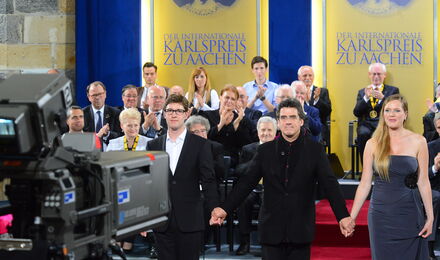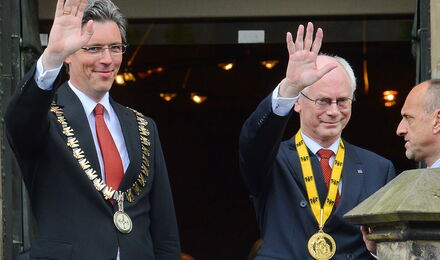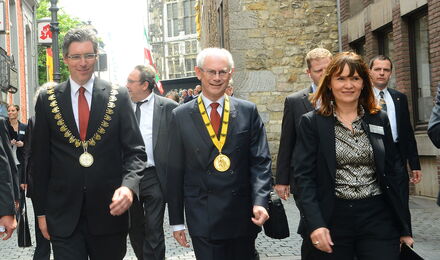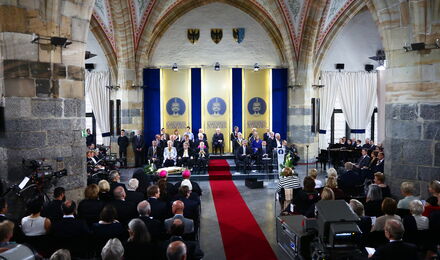In appreciation of his significant achievements as a mediator and consensus-builder, and at the same time as an important driving force behind European unification, the Board of Directors of the Society for the Conferring of the International Charlemagne Prize of Aachen honours the President of the European Council, Herman Van Rompuy, in 2014. Pragmatic and decisive, with great integrity and powers of integration, he has made a significant contribution to the consolidation and further development of the United Europe by filling this newly created office.
Herman Van Rompuy embodies the idea that Europe must be reworked every day and that it must have a vision.
While the European heads of state and government had been meeting only on ceremonial occasions for a long time, it was agreed in 1974 – almost four decades ago – that the meetings would henceforth be held regularly under the name ‘European Council’, and the Council soon developed into the most important institution when it comes to the general political direction and priorities of the EU. However, it took 35 years for the Council to become one of the EU's seven official institutions, with the entry into force of the Lisbon Treaty on 1 December 2009. The simultaneous establishment of a permanent presidency in the European Council was intended to counteract the constant change of personnel at the top of Europe's leadership caused by the six-monthly Council presidencies, to introduce continuity into the Council's work and to give the United Europe a face to its partners in the world. As the first permanent President, Herman Van Rompuy has shaped this office from the outset and has thus become one of Europe's key crisis managers and idea generators over the past four years. Herman Van Rompuy was born on 31 October 1947 in the Brussels municipality of Etterbeek. After graduating from the Catholic University of Leuven with a bachelor's degree in philosophy in 1968 and a master's degree in economics in 1971, he initially joined the Belgian National Bank before working for the Belgian government for the first time in 1975 as an adviser in the cabinet of the then Prime Minister and later Charlemagne Prize winner Leo Tindemans; In 1978, he joined the cabinet of Finance Minister Gaston Geens. From 1980 to 1988, he headed the Centre for Political, Economic and Social Studies; he also held teaching positions at the Antwerp School of Business Administration (1980-1987) and at the Vlaamse Economische Hogeschool in Brussels (1982-2008).
He began his political career as deputy chairman of the youth organisation of the CVP (1973-1977); he was a member of the national party bureau from 1978 and rose to become chairman of the Christian Democrats ten years later. In the same year, he was elected to the Belgian Senate and was briefly appointed Secretary of State for Finance and Small and Medium-sized Enterprises (May to September 1988). In September 1993, he joined Jean-Luc Dehaene's cabinet as Deputy Prime Minister and Minister for the Budget (until 1999). In this role, he made a decisive contribution to his country joining the euro by significantly reducing the national deficit. He won a seat in the Chamber of Representatives in 1995, which he retained even when his party was relegated to the opposition four years later. He was appointed an honorary ‘Minister of State’ in 2004 and elected President of the Chamber of Representatives in 2007.
After the failure of the short-lived head of government Yves Leterme, Van Rompuy – who had never aspired to this office and had already turned it down once in the 1990s – was sworn in as prime minister by Albert II in December 2008, in the midst of the worst crisis the kingdom has faced in recent history. Although he was unable to permanently resolve the bitter dispute between the Flemish and the Walloons, he did succeed in a very short time in organising constructive cooperation in the highly fragile five-party coalition and in bringing about a period of political stability to the country when a break-up seemed a real possibility. ‘It was this testimonial that persuaded the other ‘heads’ in the EU to make him permanent chairman at their Brussels round table’ (FAZ, 18 October 2012). However, it did come as a surprise to many observers when Van Rompuy was appointed as the first permanent President of the European Council at an extraordinary summit of the European Council on 19 November 2009, less than a year after taking up the post of head of government. He assumed the new role, created by the Lisbon Treaty, on 1 December, just under two weeks later.
According to the statutes, the President of the European Council represents the EU externally, ensures the preparation and chairs the work of the European Council and reports to the European Parliament on the Council's meetings. He is thus supposed to give the European Council ‘impulse’ and ‘continuity’ and promote ‘cohesion and consensus’.
Van Rompuy's particular strength is building consensus. After all, in his previous work over three decades, he had already earned a reputation as a conciliatory, diplomatically highly skilled politician – who, as his party's negotiator, played a key role in no fewer than eight cabinet formations. ‘Listening to people, having empathy for the other person's perspective, trying to find a middle ground, that's a way of behaving. Having that is very helpful when you work here as President of the Council.’
However, it is not only his ability to compromise and the pragmatism that goes with it that characterises the Belgian. Rather, an advantage of Van Rompuy's quickly emerged after he took office, which had been almost unnoticed by the public at the time of his appointment: he is one of the members of the Council who has a very broad and sound economic background. And so he is now not only highly esteemed as a moderator and consensus-builder, but has also decisively shaped the work of the Council, above all as a provider of ideas and impetus.
In the first half of 2010, the summit meetings he convened agreed on packages of measures to support Greece and to safeguard the stability of the euro, and a new strategy for growth and jobs (Europe 2020) was adopted on the Commission's proposal. ‘During the crisis,’ says Van Rompuy looking back, ‘we put together a lifeboat on the high seas. In the stormy waters of the time, that was no mean feat. However, it was clear to all of us that we would have to draw the right lessons from this experience for the future [...] Many short-term problems are due to the fact that insufficient attention has been paid to long-term structural reforms. In terms of competitiveness, research and the skills of the labour force, other major economies are making rapid progress. Employment and growth in Europe are at stake. That is why the European Council, at its meetings in March and June [2010], developed an ambitious ten-year strategy for jobs and growth under the title ‘Europe 2020’.’ The priorities of this programme are to promote research and development, as well as school and university education, to develop a sustainable energy industry and to increase energy efficiency. With its new strategy, the EU has set itself the ambitious goal of ensuring that by 2020, 75% of people aged 20 to 64 are in work and the number of people affected or threatened by poverty and social exclusion is reduced by at least 20 million.
With the decisions to establish a permanent crisis management mechanism, the pact for competitiveness (‘Euro-Plus’), the reform of the Stability and Growth Pact and the budgetary and economic governance, with the adoption of the fiscal and the ESM Treaty, among other things, the first two years of Van Rompuy's term of office were characterised by an unprecedented density of decisions. And ‘with each month of the euro crisis, Van Rompuy earned more respect from the heads of government – and ultimately also influence’ (Zeit Online, 2 March 2012). On 1 March 2012, three months before the end of his term of office, the Council President was unanimously re-elected for a further two and a half years (until 30 November 2014); at the same time, it was decided that the Belgian would also chair the Euro Summits.
No longer underestimated by anyone, he announced that he would remain true to his line in the future and would ‘primarily focus on results’. ‘He regularly meets with the ambassadors of the member states in Brussels, which is actually below his station in terms of protocol. In such rounds, it is reported, he listens very carefully to what the individual EU countries have to say. ‘He is a walking conciliation committee,’ says one diplomat. His text work is also praised as ‘masterly’, which is a cardinal virtue in the EU, which is fixated on documents' (FAZ, 18 October 2012). One of the key documents of his term of office is his report ‘Towards a Genuine Economic and Monetary Union’, which Van Rompuy wrote in close cooperation with José Manuel Barroso, Jean-Claude Juncker and Mario Draghi and subsequently supplemented with specific deadlines. The realisation of a genuine economic and monetary union as a ‘work in progress’ is now permanently on the EU agenda.
Van Rompuy is firmly convinced that the current challenges ‘make it imperative to commit to a roadmap for the path to a genuine EMU and its subsequent implementation’.
Specifically, he called for an integrated fiscal, budgetary and economic policy framework and for the necessary democratic legitimisation to be ensured. These building blocks make it clear that ‘more Europe’ is not an end in itself, but rather a service to the citizens of Europe to increase their prosperity.
The continuity of the office of a permanent Council President and Van Rompuy's efficient, pragmatic hard work and persistence have noticeably improved the European Council's ability over the past four years to set the EU's political agenda and to follow up its decisions with concrete action – especially when it comes to policy areas that fall within the responsibility of the nation states. ‘The so-called community method is and will remain the main way for the adoption of European policies and legislation,’ the Belgian makes unequivocally clear. ’However, this method, in all its variations, can only be applied in areas that fall within the competence of the Union; it cannot be applied in areas for which the Member States are responsible. Nevertheless, European coordination is sometimes indispensable in those areas as well. The economic and financial crisis has made this abundantly clear.’ And if a degree of European integration and coordination has now been achieved that seemed unthinkable just a few years ago, it is also thanks to Herman Van Rompuy's prudence and strength of action.
Van Rompuy represents the European Union together with the Commission President externally – in regular bilateral summits with Japan, the USA, Russia, South Africa, Brazil and China, at the meetings of the G8 and G20 countries, in the plenary assembly of the United Nations or in multilateral summits, which also includes the ‘Eastern Partnership’. When the signing of the Association Agreement with Ukraine recently fell through, it was the President of the European Council who warned, in unusually strong terms, against third countries interfering in the EU's relations with Eastern European countries. ‘We will not bow to Russian pressure,’ emphasised Van Rompuy, while also reiterating that the agreement with Ukraine remained “on the table” and encouraging the government in Kiev to continue on the European path: ’Now is the time for courage and decision.’
Van Rompuy calls on us Europeans to accept the conflicts in the regions neighbouring the EU as a pan-European task and to contribute to their resolution in a spirit of solidarity. Only in this way can Europe assume its global responsibility.
In the President of the European Council, Herman Van Rompuy, the Board of Directors of the Society for the Conferring of the International Charlemagne Prize of Aachen honours in 2014 a great European who, as a tireless worker, mediator and consensus-builder in difficult times, has made a significant contribution to the consolidation of the EU and who, as an important source of inspiration and ideas, provides orientation for the path that tomorrow's Europe should take.
Aachen, 7 December 2013












